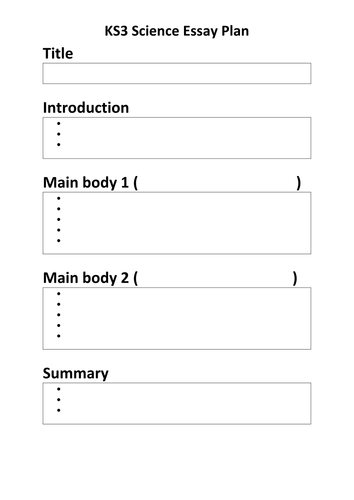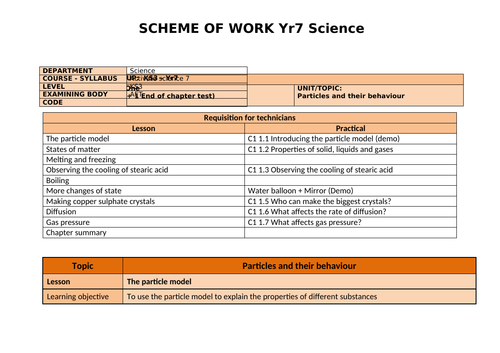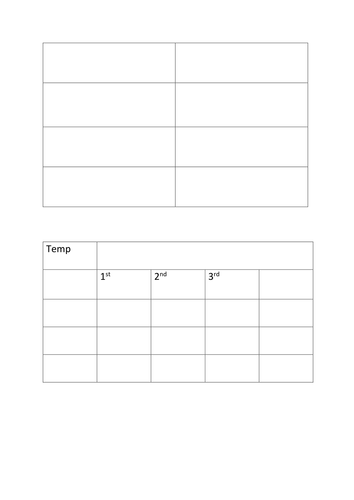243Uploads
111k+Views
55k+Downloads
Chemistry

C4.2 Equations and calculations
AQA GCSE Sciences (9-1)
Chemistry: C4 Chemical calculation
Lesson 2: C4.2 Equations and calculations
Based on the Kerboodle Resources
The AQA Kerboodle worksheet are not included so as to be acting within the TES code of conduct.

KS3 Scientific Essay Plan
I found that a lot of my KS3 were simply copying and pasting information for homework.
This was designed to get them to have to think critically about the information they are including.
Ideally, they follow the plan and you give feedback which they use along with the plan to write the actual essay.

C8.8 Dynamic equilibrium
AQA GCSE Sciences (9-1)
Chemistry: C8 Rates and equilibrium
Lesson 8: C8.8 Dynamic equilibrium
Based on the Kerboodle Resources
The AQA Kerboodle worksheet are not included so as to be acting within the TES code of conduct.

C9.4 Cracking
AQA GCSE Sciences (9-1)
Chemistry: C9 Crude oil and fuels
Lesson 4: C9.4 Cracking
Based on the Kerboodle Resources
The AQA Kerboodle worksheet are not included so as to be acting within the TES code of conduct.

C1.1 Atoms and compounds
AQA GCSE Sciences (9-1)
Chemistry: C1 Atomic structure
Lesson 1: C1.1 Atoms and compounds
Based on the Kerboodle Resources
The AQA Kerboodle worksheet are not included so as to be acting within the TES code of conduct.
Keywords: Atoms, Nucleus, Electrons, Protons, Neutrons, Elements, Groups

C1.6 Structure of the atom
AQA GCSE Sciences (9-1)
Chemistry: C1 Atomic structure
Lesson 6: C1.6 Structure of the atom
Based on the Kerboodle Resources
The AQA Kerboodle worksheet are not included so as to be acting within the TES code of conduct.
Keywords: Protons, Neutrons, Electrons, Atomic number, Mass number

C1.4 Chromatography
AQA GCSE Sciences (9-1)
Chemistry: C1 Atomic structure
Lesson 4: C1.4 Chromatography
Based on the Kerboodle Resources
The AQA Kerboodle worksheet are not included so as to be acting within the TES code of conduct.
Keywords: Retention factor

Yr7 Particles. Scheme of Work for Kerboodle Activate 1 (SoW)
Content
Lesson objective
Skills objective
Learning outcomes
Keywords
Numeracy
Practical
Homework
Misconceptions
Key questions to ask
Lesson plans:
The particle model (Practical)
States of matter (Practical)
Melting and freezing
Observing the cooling of stearic acid (Practical)
Boiling
More changes of state (Practical)
Making copper sulphate crystals (Practical)
Diffusion (Practical)
Gas pressure (Practical)
Chapter summary

KS3 Science Yr8 Chemistry Student response sheets
A collection of student feedback sheets based on exam style questions.
Best used when you have identified an area of weakness.
This should help make marking meaningful.
Topics include Periodic Table, Separation Techniques, Metals and acids, The Earth

KS3 Science Yr7 Chemistry Student response sheets
A collection of student feedback sheets based on exam style questions.
Best used when you have identified an area of weakness.
This should help make marking meaningful.
Topics include Particles, Elements and compounds, Reactions, Acids and alkalis

Science 101 (Introduction lesson 1/4)
Designed to be the first lessons for Year 7s (1/4).
Learning outcomes: (*) State what an observation is. (*) Describe the difference between observation and inference. (*) Use data to formulate an inference about fossil distribution.
Also included are sentence types (Simple, Compound, Complex) with scientific examples to build literacy skills in later lessons.

C1.8 Electronic structure
AQA GCSE Sciences (9-1)
Chemistry: C1 Atomic structure
Lesson 8: C1.8 Electronic structure
Based on the Kerboodle Resources
The AQA Kerboodle worksheet are not included so as to be acting within the TES code of conduct.
Keywords: Shells, Electronic structure, Nobel gases

C3.3 Properties of ionic compounds
AQA GCSE Sciences (9-1)
Chemistry: C3 Structure and bonding
Lesson 3: C3.3 Properties of ionic compounds
Based on the Kerboodle Resources
The AQA Kerboodle worksheet are not included so as to be acting within the TES code of conduct.

C3.2 Ionic compounds
AQA GCSE Sciences (9-1)
Chemistry: C3 Structure and bonding
Lesson 2: C3.2 Ionic compounds
Based on the Kerboodle Resources
The AQA Kerboodle worksheet are not included so as to be acting within the TES code of conduct.

Atomic Theory
In this lesson, learners will learn about the billiard ball model, plum pudding model, nuclear model and Bohr model of the atom.
They will also learn the contribution of James Chadwick and how to distinguish the different sub-atomic particles.

J J Thomson & Plum Pudding Model
Learners will discover how JJ Thomson came up with his Plum Pudding Model and will also see how Millikan discovered the charge of the electron.

Rutherford & The Nuclear Model
In this lesson, learners discover how Rutherford and his students deduced the nuclear model from the alpha scattering experiement.

C3.4 Covalent bonds
AQA GCSE Sciences (9-1)
Chemistry: C3 Structure and bonding
Lesson 4: C3.4 Covalent bonds
Based on the Kerboodle Resources
The AQA Kerboodle worksheet are not included so as to be acting within the TES code of conduct.

KS3 Science Complete Extended Writing Task (Yr7-8)
Best used just before or after finishing a topic - an ideal activity for deep marking.
Each slide contains a set of connective and also prompt ideas.
Topics included:
* Adaptation, Neutralisation, Particle theory, Detecting sound, Puberty, Drugs and health, Fossil fuels.
* Respiration, Rock cycle, Payback-time, Digestion, Diffusion, Acidification of forests, Pollination, Earth and space

Recording Data (Introduction lesson 4/4) "Graphs and Tables"
Designed to be the fourth lessons for Year 7s (4/4).
Learning outcomes:
(*) Describe the three different types of data.
(*) Calculate means.
(*) Draw a suitable graph for given measurements.
Students recap the three types of variables and then learn the three types of data (Continuous, Discrete and Categoric).
They are then shown how to fill in a results table (where the dependent and independent variables go).
They learn how to calculate means and how to plot this data onto a graph.
The steps in drawing a graph are laid out in a step by step method (designed to be down together with the whole class).
They are also informed on when to use line or bar charts.




















